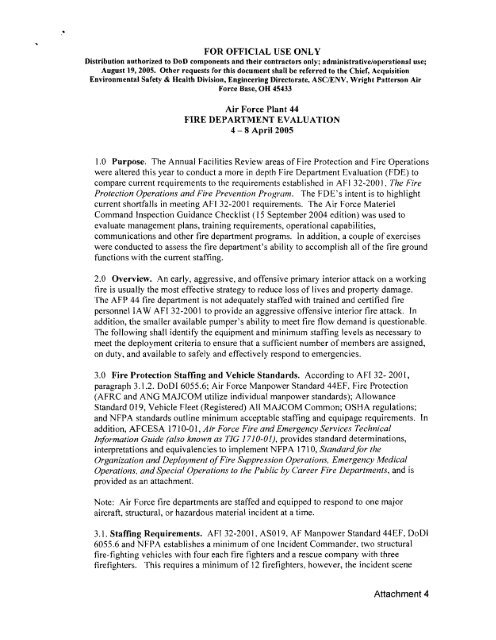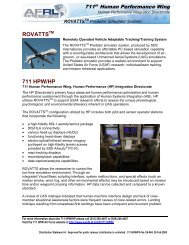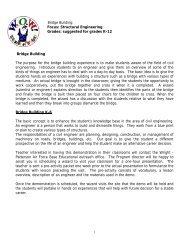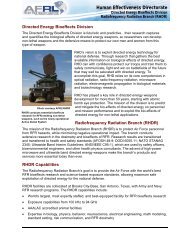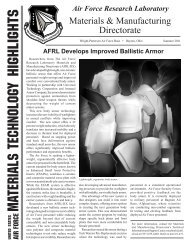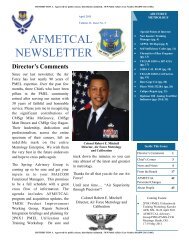Plant 44 Audit Reports - Wright-Patterson Air Force Base
Plant 44 Audit Reports - Wright-Patterson Air Force Base
Plant 44 Audit Reports - Wright-Patterson Air Force Base
- No tags were found...
Create successful ePaper yourself
Turn your PDF publications into a flip-book with our unique Google optimized e-Paper software.
,•FOR OFFICIAL USE ONLYDistribution authorized to DoD components and their contractors only; administrative/operational use;August 19,2005. Other requests for this document shall be referred to the Chief, AcquisitionEnvironmental Safety & Health Division, Engineering Directorate, ASCJENV, <strong>Wright</strong> <strong>Patterson</strong> <strong>Air</strong><strong>Force</strong> <strong>Base</strong>, OH 45433<strong>Air</strong> <strong>Force</strong> <strong>Plant</strong> <strong>44</strong>FIRE DEPARTMENT EVALUATION4 - 8 April 20051.0 Purpose. The Annual Facilities Review areas of Fire Protection and Fire Operationswere altered this year to conduct a more in depth Fire Department Evaluation (FDE) tocompare current requirements to the requirements established in AFI 32-2001. The FireProtection Operations and Fire Prevention Program. The FOE's intent is to highlightcurrent shortfalls in meeting AFI 32-2001 requirements. The <strong>Air</strong> <strong>Force</strong> MaterielCommand Inspection Guidance Checkl ist (15 September 2004 edition) was used toevaluate management plans, training requirements, operational capabilities,communications and other fire department programs. In addition, a couple ofexerciseswere conducted to assess the fire department's ability to accomplish all of the fire groundfunctions with the current staffing.2.0 Overview. An early, aggressive, and offensive primary interior attack on a workingfire is usually the most effective strategy to reduce loss of lives and property damage.The AFP <strong>44</strong> fire department is not adequately staffed with trained and certified firepersonnel lAW AFI 32-200 I to provide an aggressive offensive interior fire attack. Inaddition, the smaller available pumper's ability to meet fire flow demand is questionable.The following shall identify the equipment and minimum staffing levels as necessary tomeet the deployment criteria to ensure that a sufficient number of members are assigned,on duty, and available to safely and effectively respond to emergencies.3.0 Fire Protection Staffing and Vehicle Standards. According to AFI 32- 200 I,paragraph 3.1.2. 00016055.6; <strong>Air</strong> <strong>Force</strong> Manpower Standard <strong>44</strong>EF, Fire Protection(AFRC and ANG MAJCOM utilize individual manpower standards); AllowanceStandard 019, Vehicle Fleet (Registered) All MAJCOM Common; OSHA regulations;and NFPA standards outline minimum acceptable staffing and equipage requirements. Inaddition, AFCESA 1710-01, <strong>Air</strong> <strong>Force</strong> Fire and Emergency Services TechnicalInformation Guide (also known as TIG 1710-01), provides standard determinations,interpretations and equivalencies to implement NFPA 1710, Standardjor theOrganization and Deployment ojFire Suppression Operations, Emergency MedicalOperations, and Special Operations to the Public by Career Fire Departments, and isprovided as an attachment.Note: <strong>Air</strong> <strong>Force</strong> fire departments are staffed and equipped to respond to one majoraircraft, structural, or hazardous material incident at a time.3.1. Staffing Requirements. AFI 32-2001, ASOl9, AF Manpower Standard <strong>44</strong>EF. 00016055.6 and NFPA establishes a minimum ofone Incident Commander. two structuralfire-fighting vehicles with four each fire fighters and a rescue company with threefirefighters. This requires a minimum of 12 firefighters, however, the incident sceneAttachment 4


